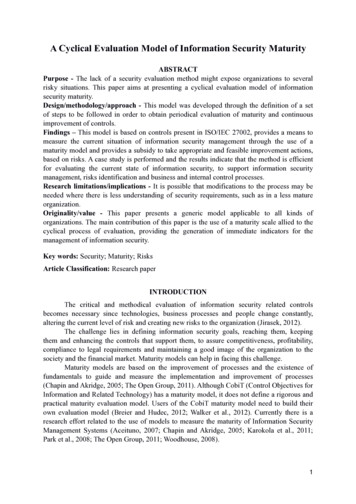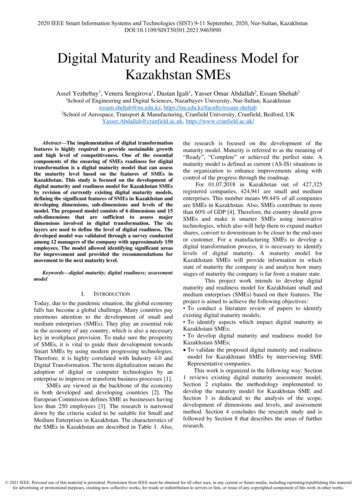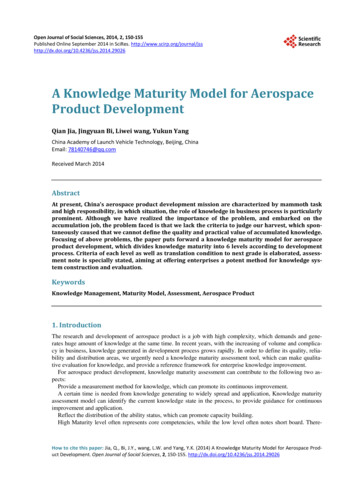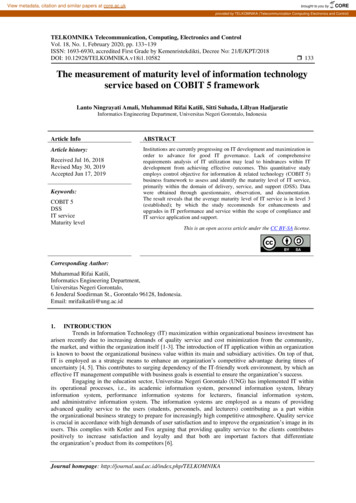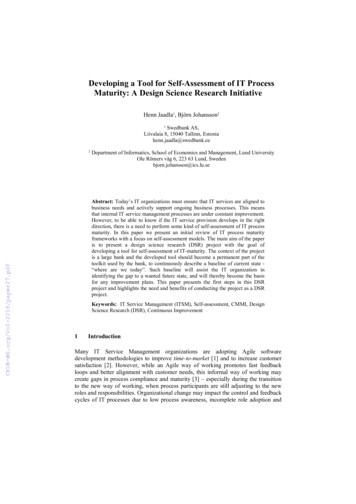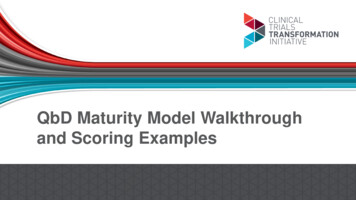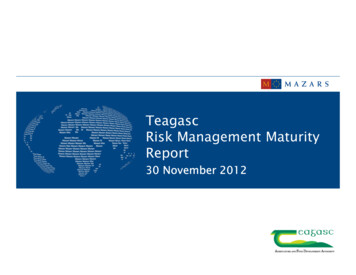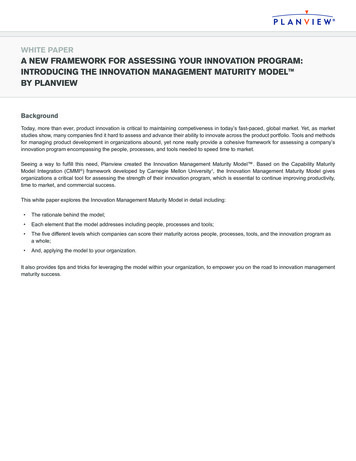
Transcription
WHITE PAPERA NEW FRAMEWORK FOR ASSESSING YOUR INNOVATION PROGRAM:INTRODUCING THE INNOVATION MANAGEMENT MATURITY MODEL BY PLANVIEWBackgroundToday, more than ever, product innovation is critical to maintaining competiveness in today’s fast-paced, global market. Yet, as marketstudies show, many companies find it hard to assess and advance their ability to innovate across the product portfolio. Tools and methodsfor managing product development in organizations abound, yet none really provide a cohesive framework for assessing a company’sinnovation program encompassing the people, processes, and tools needed to speed time to market.Seeing a way to fulfill this need, Planview created the Innovation Management Maturity Model . Based on the Capability MaturityModel Integration (CMMI ) framework developed by Carnegie Mellon University1, the Innovation Management Maturity Model givesorganizations a critical tool for assessing the strength of their innovation program, which is essential to continue improving productivity,time to market, and commercial success.This white paper explores the Innovation Management Maturity Model in detail including: The rationale behind the model; Each element that the model addresses including people, processes and tools; The five different levels which companies can score their maturity across people, processes, tools, and the innovation program asa whole; And, applying the model to your organization.It also provides tips and tricks for leveraging the model within your organization, to empower you on the road to innovation managementmaturity success.
A NEW FRAMEWORK FOR ASSESSING YOUR INNOVATION PROGRAMWHITE PAPERTable of ContentsBackground. . . . . . . . . . . . . . . . . . . . . . . . . . . . . . . . . . . . . . . . . . . . . . . . . . . . . . . . . . . . . . . . . . . . . . . . . . . . . . . . . . . . .I. Introduction . . . . . . . . . . . . . . . . . . . . . . . . . . . . . . . . . . . . . . . . . . . . . . . . . . . . . . . . . . . . . . . . . . . . . . . . . . . . . . . . . . .II. A New Way of Measuring Innovation. . . . . . . . . . . . . . . . . . . . . . . . . . . . . . . . . . . . . . . . . . . . . . . . . . . . . . . . . . . .III. Breaking the Innovation Model Down .33. . . . . . . . . . . . . . . . . . . . . . . . . . . . . . . . . . . . . . . . . . . . . . . . . . . . . . . . . .5. . . . . . . . . . . . . . . . . . . . . . . . . . . . . . . . . . . . . . . . . . . . . . . . . . . . . . . . . . . . . . . . . . . . . . . . . . . . . . . . . . . .5. . . . . . . . . . . . . . . . . . . . . . . . . . . . . . . . . . . . . . . . . . . . . . . . . . . . . . . . . . . . . . . . . . . . . . . . . . . . . . . . . . .5. . . . . . . . . . . . . . . . . . . . . . . . . . . . . . . . . . . . . . . . . . . . . . . . . . . . . . . . . . . . . . . . . . . . . . . . . . . . . . . . . . . . . .6PeopleProcessTools1VII. Translating the Levels . . . . . . . . . . . . . . . . . . . . . . . . . . . . . . . . . . . . . . . . . . . . . . . . . . . . . . . . . . . . . . . . . . . . . . . .7. . . . . . . . . . . . . . . . . . . . . . . . . . . . . . . . . . . . . . . . . . . . . . . . . . . . . . . . . . . . . . . . . . . . . . . . . . . . . .7. . . . . . . . . . . . . . . . . . . . . . . . . . . . . . . . . . . . . . . . . . . . . . . . . . . . . . . . . . . . . . . . . . . . . . . . . . . . . . . . . . . .7Levels 1 and 2Level 3 .Levels 4 and 5. . . . . . . . . . . . . . . . . . . . . . . . . . . . . . . . . . . . . . . . . . . . . . . . . . . . . . . . . . . . . . . . . . . . . . . . . . . . . .VII. Applying the Model to Your Organization .Bring Objectivity to the Process. . . . . . . . . . . . . . . . . . . . . . . . . . . . . . . . . . . . . . . . . . . . . . . . . . . . .7. . . . . . . . . . . . . . . . . . . . . . . . . . . . . . . . . . . . . . . . . . . . . . . . . . . . . . . . . . . . . . .7. . . . . . . . . . . . . . . . . . . . . . . . . . . . . . . . . . . . . . . . . . . . . . . . . . . . . . . . . . . . . .8. . . . . . . . . . . . . . . . . . . . . . . . . . . . . . . . . . . . . . . . . . . . . . . . . . . . . . . . . . . . . . .8Establish the Necessary Culture .Determine Where You’re Going72
WHITE PAPERA NEW FRAMEWORK FOR ASSESSING YOUR INNOVATION PROGRAMIntroductionIn a recent Tech Clarity Insight white paper, industry analyst Jim Brown asks: “Product innovation is critical to differentiate and remaincompetitive in today’s fast-paced, global markets. Bolstering innovation to a core competency helps manufacturers drive higher revenue,lower cost, and mitigate risk. So why is it so hard for companies to improve innovation performance and drive meaningful business value?”Why indeed? Best practices and methods for managing product development in organizations abound, yet none really provide acohesive way to accurately measure the level of innovation associated with the process – which is key to gaining market share intoday’s increasingly competitive global landscape. So, how then does an organization determine where they stand from an innovationmanagement perspective and identify ways to take it to the next level?This is the question we recently addressed at Planview, where we’ve focused on project portfolio management (PPM) for the past 24years. We wanted to put substance around the concept of innovation and give organizations a critical framework for assessing theirinnovation management maturity level, which we believe is essential to continue improving productivity, time to market, and commercialsuccess.A New Way of Measuring InnovationThe Innovation Management Maturity Model by Planview is based on the Capability Maturity Model Integration (CMMI ) frameworkdeveloped by Carnegie Mellon University.1 Designed for product organizations, the Innovation Management Maturity Model includesthree factors which are essential to an effective innovation program: people, processes, and tools. This model encompasses the entirefull product lifecycle from idea to launch and through to end of life. While the industry is hyper-focused on idea to launch, innovation doesnot stop there. Being able to manage it once each product is in market is important, as are the processes, effort, and money necessaryto terminate it.The Innovation Management Maturity Model gives organizations the ability to rank themselves on the strength of their innovation programin the categories of people, processes, and tools across five levels of maturity. Level 1 represents the lowest level of maturity while Level 5is the highest, where innovation is highly optimized across people, processes, and tools. Programs can be given an overall ranking as wellas a ranking across each category. The model provides not just a level, but also a way to compare your organization to the characteristicsand best practices of other organizations across the categories.Level 5Level 4Level 3Level 2Level 1StrategyPeopleProcessToolsWe are in a mature market where revenue is primarily drivenfrom existing products and minor line extensions. There issome innovation in process and operations throughout theorganization, but it is not required for company success. Ourstrategy is focused on conservative investments resulting ingradual and predictable growth. No cross-functional organization focused on innovation Decision making about the product portfolio by executiveleadership only, often with less than optimal data Informal project leadership; resources assigned verbally Execution and product launches happen slow and steady Unclear connection/hand-offs throughout commercializationprocess Processes are departmentally focused and notdocumented No formal gated process or templates for productdevelopment; projects rarely killed Limited visibility into actuals, forecasts, post-mortemassessment, or roadmaps; no portfolio reviews Processes surrounding ideation, roadmapdevelopment, and portfolio reviews do not exist Manual, decentralized, un-integrated spreadsheetsand basic project tracking tools Only one or two centralized applications are in use New ideas for innovation captured informally Reporting inconsistent and roadmapping rare,executed via local desktop toolsDelivery of products, mostly line extensions and solidenhancements to existing products, is growing in consistency,but we typically operate in reaction mode. Our leadership isstarting to understand the need for investing in innovation.Our innovation strategy centers on safe bets with occasionalcalculated risks, resulting in unpredictable outcomes. Individual leaders own day-to-day processes and areresponsible for developing and delivering the productroadmap Project managers not consistently following industry bestpractices Cross-functional project teams not optimized for efficiency Innovation leaders starting to emerge and introduce change Informal process for innovation and idea flow;templates in use Portfolio reviews are more project status updates Metrics for evaluating innovation are purely financial Early realization of silo inefficiency and value of gatedprocesses with cross-functional participation We are becoming more proactive in seeking innovation as akey part of our product portfolio. Our innovation strategy andmetrics are not clearly defined and communicated, and as aresult we occasionally miss market windows and margintargets. Our leadership team is actively investing in tools,processes, and capabilities to operationalize innovation. Established roles in the commercialization process: processmanagers, project manager, resource managers, and gatekeepers Beginning to champion innovation and portfoliomanagement Documented and validated gated commercializationprocess in place based on best practice Regular portfolio reviews and post-mortemsconducted Voice of the customer becoming more formalized Governance workflow not yet consistently repeatable A few projects being killed, but later than optimal Our innovation strategy is emerging and we are working to tieit to our strategic objectives for growth. The lack of connectionbetween project execution and product/corporate strategyresults in an unbalanced portfolio making it difficult to quicklyrespond to market changes. There is a growing innovationpipeline, we are getting to market faster, and we are achievingmany of our performance metrics. Innovation efforts havevisibility, but it’s not yet embedded in our culture. Early formation of a “Center for Process Excellence” Process managers and gatekeepers have clear direction,metrics, and ownership Formalized portfolio manager positions at business unit andenterprise levels Multiple strong champions for innovation Project teams consist of cross-functional team members Start of open innovation, co-development, and the use ofexternal innovation consultants Fully implemented gated process across multipleteams with some automation Gaining courage killing underperforming projects Portfolio metrics expanded to include resourcecapacity and strategic alignment Capturing voice of the customer with caution Governance process becoming efficient andstreamlined Product Portfolio Management (PPM) system in placeautomating the commercialization process Resource capacity planning, roadmapping, andfinancial forecasting being piloted within PPM Dedicated tool for capturing voice of the customer Executive and project-level reporting and analyticsare available and modifiableWe have operationalized innovation with well-definedprocesses and formalized tools. Innovation is embedded in ourcompany culture across all functions. We have a well-balancedportfolio with incremental and breakthrough innovation thatyields positive revenue growth. We have the ability to launchproducts as planned and with confidence, meeting time tomarket targets. Executive leadership fosters innovation “Center for Process Excellence and Innovation” is wellestablished and reports to executive team Decision making is collaborative and efficient Everyone throughout the commercialization processunderstands role Project managers and scrum masters lead innovation anddevelopment teams leveraging best practices Fully automated and standardized processes that areeasily adaptable Portfolio metrics evolved to include competitive andenvironmental impact scores Projects killed early and often during portfolio reviews Voice of the customer captured on an ongoing basis Continuous learning loop well established Process covers idea to launch, and through to end oflife Highly functioning PPM system integrated to otherenterprise tools Ideation collected for collaboration Product roadmap tied to project execution andcorporate strategy via PPM Entire product catalog of in-market products,including the Product P&L, managed via PPM Self-service configurable reports and metricsdelivered across the organizationMoving to shared spreadsheets in central locationIdeation matured to being captured and prioritizedProjects managed via desktop tool but not sharedRoadmap communicated via static spreadsheet;rarely updated Reporting and analytics starting to be shared andbuilt manuallyManual portfolio management using spreadsheetsDesktop project management tools in useSoon to automate the commercialization processIdeation centralized but not using a purpose built toolStandard library of reports exist; created manually byITWant to learn more about the Innovation Maturity Model and how your organization can increase its maturity over time? Please contact market@planview.com.Innovation Management Maturity Model by Planview. Download a copy at t Planview – Planview is a portfolio and resource management company that helps organizations maximize business opportunities by optimizing the capacity of their finite people and financial resources. Within Product Development, market leaders rely onPlanview software to collect input from customers, prioritize the best product portfolio, build the product roadmap, and manage the execution of bringing those products to market. Planview’s singular focus on portfolio management and customer-centric culturefuels a deep commitment to continuous innovation and customer success, and is the reason it is recognized globally as a market leader. Learn more at www.planview.com.Copyright 2013 Planview, Inc., All rights reserved.1Capability Maturity Model Integration Framework, ei/featuresept98pdf.cfm3
A NEW FRAMEWORK FOR ASSESSING YOUR INNOVATION PROGRAMWHITE PAPERThe ability to rank each aspect of your organization’s innovation management maturity is important for several reasons. To begin with,while innovation is on everyone’s mind, there is no clear-cut path of how to manage it because it’s widely believed to be a purely creativeprocess. While this in large part is true, not having a way to measure and manage it leaves most organizations rudderless, with eithernebulous approaches to drive innovation or a dependency on individual ideas that often turn into pet projects without validation oftheir true value in the overall product portfolio strategy. The Innovation Management Maturity Model provides a framework that definesthe level of innovation management across the product portfolio and unifies it with strategy and execution, which is a very powerfulcombination. This ability to establish a definition of the true state of innovation management in the organization creates a benchmark ofperformance that can potentially unify disparate opinions, against which performance (either departmental or across the organization) canbe monitored and measured. Ultimately, it is a powerful way to operationalize innovation and ensure it is embedded into every aspect ofthe product development process and the organizational mindset toward it.This model has proven to be eye-opening for many organizations. In the Fourth Product Portfolio Management Benchmark Study morethan 700 product development executives and managers were asked to evaluate their organization’s level of innovation maturity. Themajority of organizations, many large, global entities, ranked their innovation maturity between a two and three.Which of the following best describes the innovation maturity level of yourcompany in terms of people, processes, tools, and overall?Yet, when asked to rank where they want to be in terms of innovation maturity, the majority of respondents indicated that they desired toachieve a Level 4 or 5.Which of the following best describes your company’s end goalin terms of desired innovation maturity level?What also emerged in these findings is that often there is a disparate viewpoint across the organization as to the true state of innovationmanagement maturity. One global manufacturer shared, “Upper management is thinking we are a Level 4 right now. While the vision andintention are there, most in our group would look at the description of Level 4 maturity and say we are not there yet. We are very financiallyfocused but we are not resource and capacity aware.”The Innovation Management Maturity Model provides a tangible way to gain agreement across the organization of where things standtoday, and what the desired level of innovation management maturity is. For some organizations, it will be important to strive for a Level5 while others may be comfortable working toward a Level 3. Either way, this model is an effective tool to define goals and measureprogress in a more uniform and more objective manner.4
A NEW FRAMEWORK FOR ASSESSING YOUR INNOVATION PROGRAMWHITE PAPERHOW DO YOU STACK UP WHEN IT COMES TO INNOVATION MANAGEMENT?Find out at Planview.com/InnovationMaturityBreaking the Innovation Management Maturity Model Down“Our motivation to move up in the maturity model is to increase shareholder value by obtaining and maintaining market sharethrough innovation and growth which are key to those objectives.” – Consumer Food ManufacturerTo gain an understanding of how the Innovation Management Maturity Model works, let’s examine the individual categories of people,processes and tools.PeopleThis is about having an organizational structure that supports innovation, with people whose jobs are to manage the innovation portfolio.The highest maturity organizations have a Center for Process Excellence that is productive, well established, and well-staffed. Theyalso have support from executive leadership and department heads who know that innovation is how the business will grow, meet thecorporate strategy, and thrive. Decision-making in the high maturity innovation organization is collaborative and efficient. Everyonethroughout the commercialization process understands their role and part in delivering against the objectives of innovation. Highly trainedproject managers and Scrum masters lead innovation and development teams, leveraging industry best practices to meet deliverable andproduct launch targets. While this is an ideal scenario, the majority of organizations surveyed in the Fourth Product Portfolio ManagementBenchmark Study ranked themselves as a Level 3 or lower.Which of the following best describes the innovation maturity level of yourcompany in terms of PEOPLE?“Our most pressing concern around product portfolio management is getting the organization to manage the people changemanagement aspect required. The benefit of PPM does not exist at the individual marketing or innovation project manager, but tothe broader organization and the innovation pipeline. In the long term, I believe project managers can become more successful.However, up front it is perceived to be added work they do not need.” – Fortune 1000 Company ExecutiveProcessesThis refers to the automation of the commercialization process. Organizations at the highest maturity level have dynamic processes thatcan easily be adapted as the market changes and the company evolves. They have fully automated and standardized processes that arein a regular state of continuous improvement, including process deliverables, templates, and reports. Portfolio metrics have evolved frombeing focused on product financials to include resource capacity, competitive impact and environmental impact scores. Projects are killedearly and often during portfolio reviews.5
A NEW FRAMEWORK FOR ASSESSING YOUR INNOVATION PROGRAMWHITE PAPERAdditionally, the voice of the customer is captured on an ongoing basis, using targeted challenges to drive innovation and maintain brandloyalty. A continuous learning loop is well established and effectively incorporates post-launch learnings back into the commercializationprocess. Similar to the rankings for People, the majority of organizations ranked themselves a Level 3 or lower in terms of Processes.Which of the following best describes the innovation maturity level of yourcompany in terms of PROCESSES?“Some of our brands have a buttoned up innovation processes and others kind of wing it. As a company though, we are goingthrough a stage gate improvement process to create better adherence to the process and this is driven top-down.” – CPG FoodManufacturerToolsThis refers to having a PPM system in place to automate processes, which are rolled out to everyone along the commercializationprocess. The PPM application is integrated with other enterprise applications, such as the ERP and the PLM. Ideas are collected viapurpose-built, externally available applications for customer and company-wide collaboration. The product roadmap is tied to corporatestrategy and project execution via the PPM application. What-if analysis is performed against resource capacity to consistently hit launchwindows. The entire product catalog of in-market products, including the product P&L, is managed via the PPM application to leverageplatform components across multiple products. Self-service, configurable reports and metrics are delivered across the organization tothose who need access, in a format and device that works best for each individual user. As with People and Process, most organizationsfeel they are a Level 3 or lower when it comes to effective use of Tools in their product portfolio management.Which of the following best describes the innovation maturity level of yourcompany in terms of TOOLS?“We are honing our product innovation pipeline, we are a level 3, absolutely moving to level 4. What’s holding us back right nowis that collectively as a group we are not locked into the key tools to get us there, in fact 25–40% of our cross functional groupsstill don’t know about PPM and we need better cross discipline buy-in.” – CPG Food Manufacturer6
A NEW FRAMEWORK FOR ASSESSING YOUR INNOVATION PROGRAMWHITE PAPERHOW DO YOU STACK UP WHEN IT COMES TO INNOVATION MANAGEMENT?Find out at Planview.com/InnovationMaturityTranslating the LevelsTo bring these categories together, what does an organization look like at each level?Levels 1 and 2Organizations at these levels tend to share many concerns, reflective of the fact that both lack, to a greater or lesser extent, the technologicaland process support structures that would lessen data, communication, and planning problems. They have also not established resourceroles that ensure inter-team communication, as, in even the best-case scenario, individuals within business units own roadmap definitionand execution.However, in some cases, innovation management around a particular product is not an internal priority and an organization mayintentionally stay at a Level 1 or 2. This is often seen in products that are considered “cash cows” according to the BCG Matrix, whereinnovation is less important than continuing to receive the revenue stream the product generates. This revenue can then be used to fundother products where a focus on innovation management is key.Level 3Organizations at this level have crossed the technology chasm from their lower maturity level colleagues by using technology to plan,find and leverage information, and keep execution on track. With gated commercialization processes in place and established process,resource, and project managers breaking down communication silos, these organizations are seeing definite benefits of moving up thematurity model.Levels 4 and 5These organizations have embraced the journey of advancement and, by and large, recognize that innovation maturity is not accidental.They have invested in planned growth across people, process, and tools to drive faster yet sustainable and repeatable innovationpractices. They have formed cross-functional project teams that support open innovation; their processes are dynamic and adapt tochange; and they leverage product portfolio management solutions to do it all.Applying the Model to Your OrganizationWhile the Innovation Management Maturity Model provides a method to assess the level of innovation maturity in an organization, thereare some “tips and tricks” for getting the most out of it.Bring Objectivity to the ProcessWhile the model will help start the conversation in your organization about the level of innovation management maturity within people,processes, and tools, you will likely discover that there will be discrepancies between where people in the product development organizationthink the company is versus where executive leadership thinks it is. Uncovering any disconnects between perceptions of how evolvedinnovation is within the organization could present a problem. The model will help everyone take an honest look at each maturity level,and objectively assess and agree on where they stand and where they want to get to. Gaining agreement across the organization andestablishing the right culture to support changes which enhance the innovation program are critical for this model to be truly effective.7
A NEW FRAMEWORK FOR ASSESSING YOUR INNOVATION PROGRAMWHITE PAPEREstablish the Necessary CultureHigh maturity companies have innovation embedded in their company cultures from the boardroom to individual contributor levels acrossall functions. It’s essential to have a culture that isn’t afraid to fail and, in fact, celebrates failure, learns from it, and moves on quickly. Thisnecessary culture comes from the top down, which is why you can’t do this on your own. Buy-in and support from executive managementon down is crucial to having an effective innovation program.Determine Where You’re GoingIf you’re going to speed time to market and move quickly, you need to have a clear direction and strategy about where to go and how toget there. The Innovation Management Maturity Model not only lets you define where you are today, but also helps you decide whereyou want to go and develop a strategy for how to get there. And, linking that strategy to investments and execution is the way into thewinner’s circle.Learn More about the Innovation Management Maturity ModelThe Innovation Management Maturity Model by Planview is available at Planview.com/InnovationMaturity.To see how your company compares to other organizations across the globe and to get more insight into innovation and the productdevelopment discipline as a whole, download the latest version of the Product Portfolio Management Benchmark Study conducted byAppleseed Partners and Open Sky Research and commissioned by Planview, at Planview.com/Benchmark.8
A NEW FRAMEWORK FOR ASSESSING YOUR INNOVATION PROGRAMWHITE PAPERIX. About the AuthorCarrie Nauyalis, New Product Development SolutionEvangelist at Planview, is passionate about establishingcustomer partnerships, developing market positioning,defining field enablement strategies, providing market-basedfeedback into Planview product development, and beingan overall evangelist and thought leader for the ProductDevelopment market.She is an active speaker, MBA guest lecturer, blogger, and vlogger on all thingsProduct Portfolio Management, with warm places in her heart for the topics ofinnovation, Stage-Gate, and Agile.Planview is a portfolio and resource managementcompany that helps organizations maximize businessopportunities by optimizing the capacity of their finitepeople and financial resources. Market leadersrely on the company’s solutions to manage a widerange of portfolios, spanning product development,IT, services, and corporate finance, resulting in anenterprise-wide view of resources against demands.For more information, visit www.planview.com. 2013 Planview, Inc. All rights reserved. Alltrademarks acknowledged.WWW.PLANVIEW.COM MARKET@PLANVIEW.COM 800.856.8600 1.512.346.8600 PW002
Based on the Capability Maturity Model Integration (CMMI ) framework developed by Carnegie Mellon University1, the Innovation Management Maturity Model gives organizations a critical tool for assessing the strength of their innovation program, which is essential to continue improving productivity, time to market, and commercial success. This .



